新版公共服务领域英文译写规范
- 格式:doc
- 大小:29.33 KB
- 文档页数:13
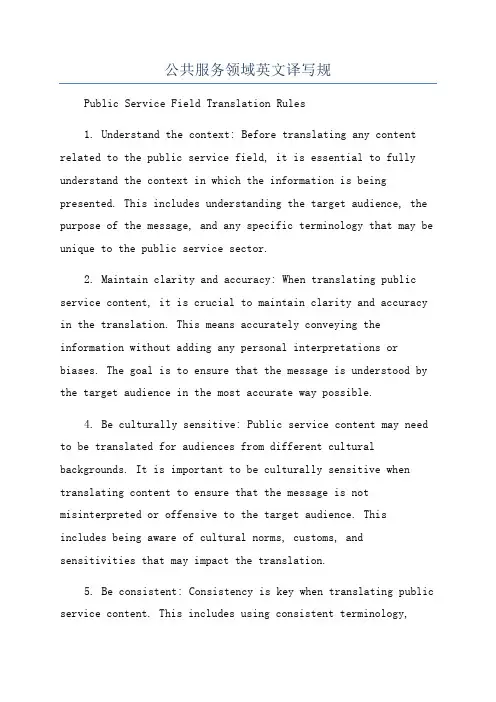
公共服务领域英文译写规Public Service Field Translation Rules1. Understand the context: Before translating any content related to the public service field, it is essential to fully understand the context in which the information is being presented. This includes understanding the target audience, the purpose of the message, and any specific terminology that may be unique to the public service sector.2. Maintain clarity and accuracy: When translating public service content, it is crucial to maintain clarity and accuracy in the translation. This means accurately conveying the information without adding any personal interpretations or biases. The goal is to ensure that the message is understood by the target audience in the most accurate way possible.4. Be culturally sensitive: Public service content may need to be translated for audiences from different cultural backgrounds. It is important to be culturally sensitive when translating content to ensure that the message is not misinterpreted or offensive to the target audience. This includes being aware of cultural norms, customs, andsensitivities that may impact the translation.5. Be consistent: Consistency is key when translating public service content. This includes using consistent terminology,style, and tone throughout the translation. This helps to maintain the integrity of the message and ensures that the content is cohesive and easily understood by the target audience.6. Proofread and edit: Before finalizing any translation in the public service field, it is important to proofread and edit the content carefully. This helps to eliminate any errors, typos, or inaccuracies that may have been missed during the initial translation process. Proofreading ensures that the final translation is of the highest quality and accurately conveys the intended message.7. Seek feedback: It can be helpful to seek feedback from native speakers or subject matter experts in the public service field. This feedback can provide valuable insights and help ensure that the translation is accurate, clear, and culturally appropriate. Incorporating feedback into the translation process can help improve the overall quality of the final translation.8. Stay updated: The public service field is constantly evolving, and new terminology, regulations, and guidelines maybe introduced regularly. It is important to stay updated on any changes in the field and to adapt translations accordingly. This helps to ensure that the content remains relevant and accurately reflects the current state of the public service sector.。
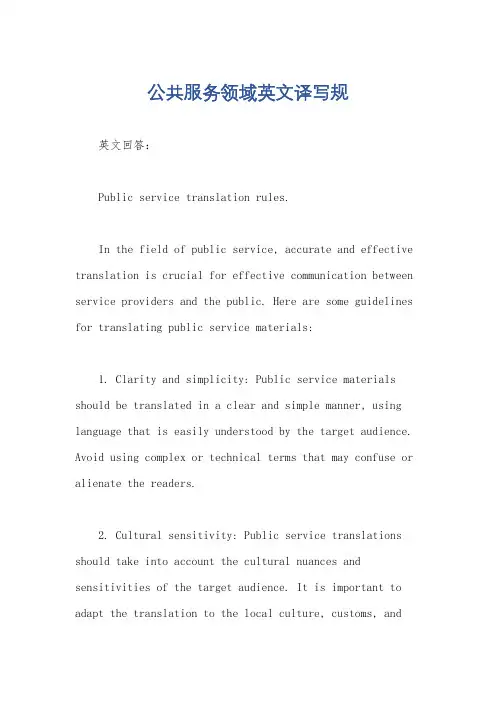
公共服务领域英文译写规英文回答:Public service translation rules.In the field of public service, accurate and effective translation is crucial for effective communication between service providers and the public. Here are some guidelines for translating public service materials:1. Clarity and simplicity: Public service materials should be translated in a clear and simple manner, using language that is easily understood by the target audience. Avoid using complex or technical terms that may confuse or alienate the readers.2. Cultural sensitivity: Public service translations should take into account the cultural nuances and sensitivities of the target audience. It is important to adapt the translation to the local culture, customs, andvalues to ensure that the message is well-received and understood.3. Accuracy and consistency: Public servicetranslations should be accurate and consistent with the original source text. It is important to convey the intended meaning of the original message without distorting or misinterpreting the information.4. Plain language: Public service translations should use plain language, avoiding jargon, acronyms, and overly formal or legalistic terms. The goal is to make the information accessible and easy to understand for all members of the public.5. Accessibility: Public service translations should be accessible to all individuals, including those with disabilities. Consideration should be given to providing alternative formats, such as braille or audio versions, to ensure equal access to information.6. Proofreading and editing: Public servicetranslations should undergo thorough proofreading and editing to eliminate errors, inconsistencies, and ambiguities. It is important to review the translated text carefully before finalizing and publishing it.中文回答:公共服务领域英文译写规则。
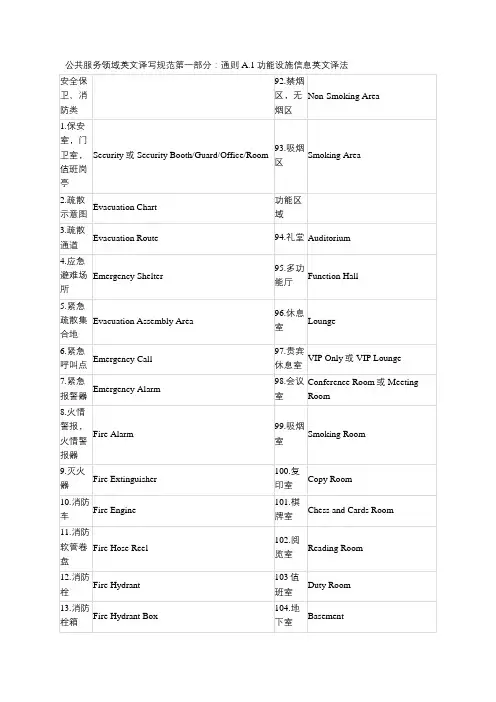
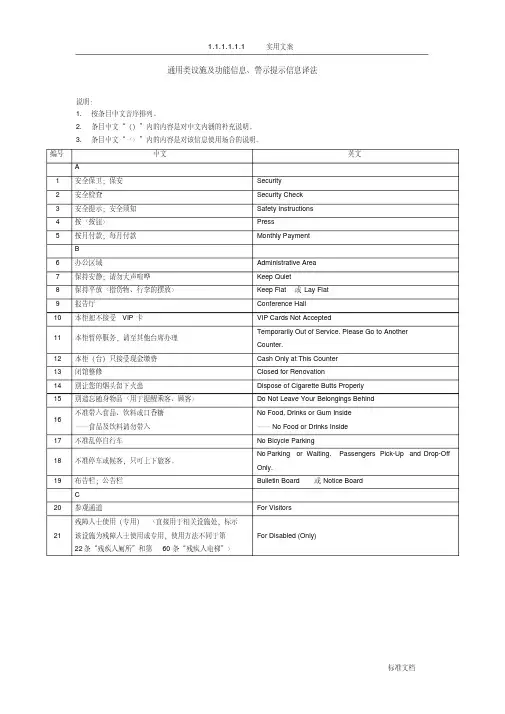
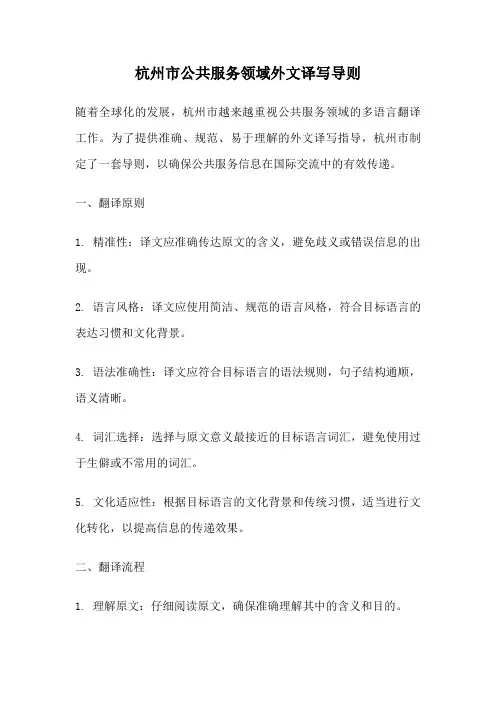
杭州市公共服务领域外文译写导则随着全球化的发展,杭州市越来越重视公共服务领域的多语言翻译工作。
为了提供准确、规范、易于理解的外文译写指导,杭州市制定了一套导则,以确保公共服务信息在国际交流中的有效传递。
一、翻译原则1. 精准性:译文应准确传达原文的含义,避免歧义或错误信息的出现。
2. 语言风格:译文应使用简洁、规范的语言风格,符合目标语言的表达习惯和文化背景。
3. 语法准确性:译文应符合目标语言的语法规则,句子结构通顺,语义清晰。
4. 词汇选择:选择与原文意义最接近的目标语言词汇,避免使用过于生僻或不常用的词汇。
5. 文化适应性:根据目标语言的文化背景和传统习惯,适当进行文化转化,以提高信息的传递效果。
二、翻译流程1. 理解原文:仔细阅读原文,确保准确理解其中的含义和目的。
2. 词汇翻译:根据原文的词汇和语境,选择合适的目标语言词汇进行翻译。
3. 句子重组:根据目标语言的语法规则,调整句子结构,使其通顺且易于理解。
4. 校对修改:对译文进行反复校对和修改,确保语义准确、流畅自然。
三、常用翻译技巧1. 同义替换:根据上下文意义,选择与原文相近的词语进行翻译,避免直译的生硬效果。
2. 补充说明:在译文中适当加入必要的补充说明,以确保信息的完整性和准确性。
3. 解释注释:对于一些特定的概念或文化背景,可以在译文中进行解释或注释,以提高读者的理解能力。
四、样例翻译原文:杭州市市民服务中心提供公共服务。
译文:Hangzhou Citizen Service Center provides public services.原文:请携带有效证件办理业务。
译文:Please bring valid identification documents to handle the business.原文:停车场位于市中心,方便市民出行。
译文:The parking lot is located in the city center, which is convenient for citizens' travel.原文:市民可通过手机APP查询公共交通信息。
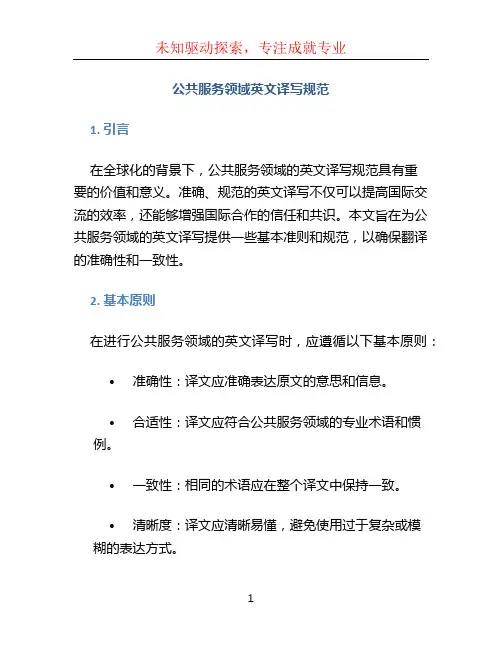
公共服务领域英文译写规范1. 引言在全球化的背景下,公共服务领域的英文译写规范具有重要的价值和意义。
准确、规范的英文译写不仅可以提高国际交流的效率,还能够增强国际合作的信任和共识。
本文旨在为公共服务领域的英文译写提供一些基本准则和规范,以确保翻译的准确性和一致性。
2. 基本原则在进行公共服务领域的英文译写时,应遵循以下基本原则:•准确性:译文应准确表达原文的意思和信息。
•合适性:译文应符合公共服务领域的专业术语和惯例。
•一致性:相同的术语应在整个译文中保持一致。
•清晰度:译文应清晰易懂,避免使用过于复杂或模糊的表达方式。
3. 专有名词的译写格式在公共服务领域的英文译写中,对于专有名词的译写应遵循以下格式:•机构名称:应尽量保持与原文相似的写法,如United Nations(联合国)。
•特定领域名称:可以直接采用原文,如education (教育)、healthcare(医疗保健)等。
•口语化表达:对于口语化的专有名词,可以根据需要进行翻译或直接使用原文,如social distancing(社交距离)。
4. 常见术语的译写规范公共服务领域存在一些常见的术语,对于这些术语的译写应遵循以下规范:•直译:对于与原文意思相符的术语,可以直接进行翻译,如public transportation(公共交通)、publicsafety(公共安全)。
•归化翻译:对于一些常见的术语,可以采用与目标语言相符的表达方式,如社区卫生服务站可以翻译为Community Health Center。
•统一标准翻译:对于一些特定领域的术语,应制定统一的翻译标准,以确保在不同文档中的一致性。
5. 常见问题及解决方法在公共服务领域的英文译写中,常常会遇到一些问题,下面是一些常见问题及解决方法:•歧义性:当原文表达含糊不清或存在歧义时,应根据上下文和专业知识进行判断和推断,确保译文的准确性。
•文化差异:在进行跨文化翻译时,需要考虑不同文化之间的差异,避免直接翻译产生的误解或不准确的表达。
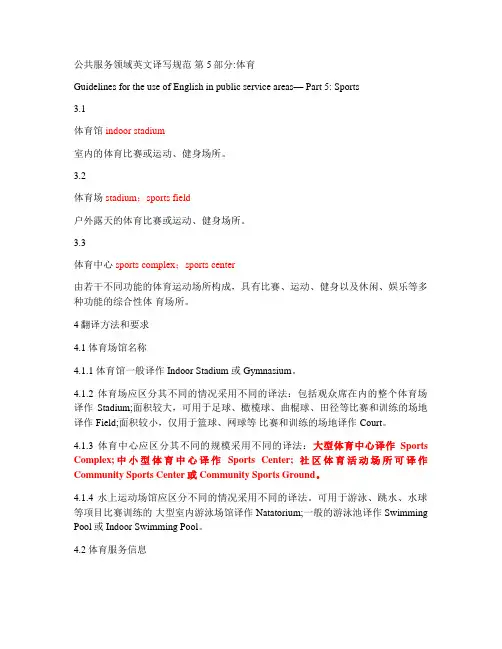
公共服务领域英文译写规范第5部分:体育Guidelines for the use of English in public service areas— Part 5: Sports3.1体育馆 indoor stadium室内的体育比赛或运动、健身场所。
3.2体育场stadium;sports field户外露天的体育比赛或运动、健身场所。
3.3体育中心sports complex;sports center由若干不同功能的体育运动场所构成,具有比赛、运动、健身以及休闲、娱乐等多种功能的综合性体育场所。
4翻译方法和要求4.1体育场馆名称4.1.1 体育馆一般译作 Indoor Stadium 或 Gymnasium。
4.1.2体育场应区分其不同的情况采用不同的译法:包括观众席在内的整个体育场译作Stadium;面积较大,可用于足球、橄榄球、曲棍球、田径等比赛和训练的场地译作Field;面积较小,仅用于篮球、网球等比赛和训练的场地译作Court。
4.1.3体育中心应区分其不同的规模采用不同的译法:大型体育中心译作Sports Complex;中小型体育中心译作Sports Center; 社区体育活动场所可译作Community Sports Center或Community Sports Ground。
4.1.4水上运动场馆应区分不同的情况采用不同的译法。
可用于游泳、跳水、水球等项目比赛训练的大型室内游泳场馆译作Natatorium;一般的游泳池译作Swimming Pool或Indoor Swimming Pool。
4.2体育服务信息4.2.1体育场馆的入场门应区分不同的情况采用不同的译法:以数字命名的入场门用“Gate+阿拉伯数字”的方式译写,如一号门译作Gate 1; 以方位词命名的入场门用“方位饲+Gate”的方式译写,如东门译作 East Gate。
4.2.2体育场馆的座位分区或区分不同的情况采用不同的译法:以数宇命名的分区用“Zone+阿拉伯数宇”或“Section+阿拉伯数字”的方式译写,如一区译作Zone 1或Section 1;以方位词命名的分区用“方位问+Section”的方式译写,如东区译作East Section。
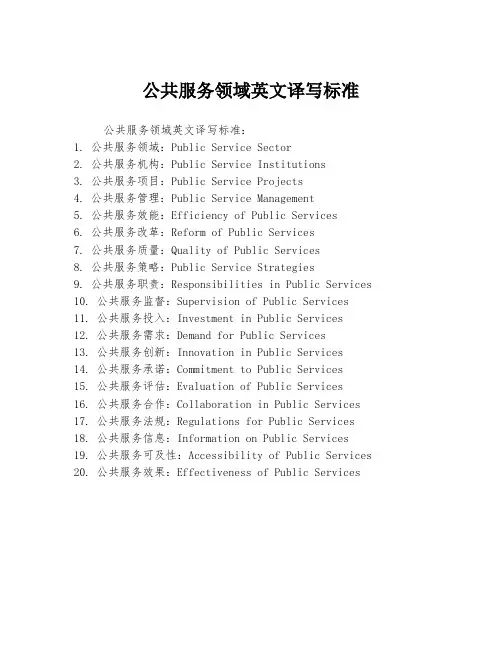
公共服务领域英文译写标准公共服务领域英文译写标准:1. 公共服务领域:Public Service Sector2. 公共服务机构:Public Service Institutions3. 公共服务项目:Public Service Projects4. 公共服务管理:Public Service Management5. 公共服务效能:Efficiency of Public Services6. 公共服务改革:Reform of Public Services7. 公共服务质量:Quality of Public Services8. 公共服务策略:Public Service Strategies9. 公共服务职责:Responsibilities in Public Services10. 公共服务监督:Supervision of Public Services11. 公共服务投入:Investment in Public Services12. 公共服务需求:Demand for Public Services13. 公共服务创新:Innovation in Public Services14. 公共服务承诺:Commitment to Public Services15. 公共服务评估:Evaluation of Public Services16. 公共服务合作:Collaboration in Public Services17. 公共服务法规:Regulations for Public Services18. 公共服务信息:Information on Public Services19. 公共服务可及性:Accessibility of Public Services20. 公共服务效果:Effectiveness of Public Services。
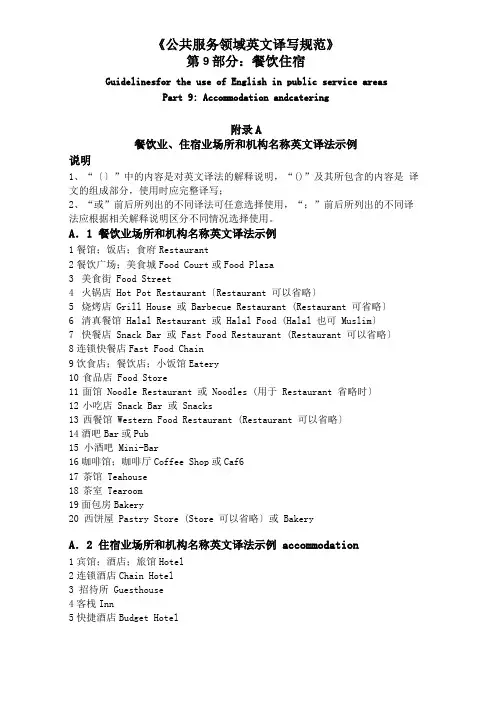
《公共服务领域英文译写规范》第9部分:餐饮住宿Guidelinesfor the use of English in public service areasPart 9: Accommodation andcatering附录A餐饮业、住宿业场所和机构名称英文译法示例说明1、“〔〕”中的内容是对英文译法的解释说明,“()”及其所包含的内容是译文的组成部分,使用时应完整译写;2、“或”前后所列出的不同译法可任意选择使用,“;”前后所列出的不同译法应根据相关解释说明区分不同情况选择使用。
A.1 餐饮业场所和机构名称英文译法示例1餐馆;饭店;食府Restaurant2餐饮广场;美食城Food Court或Food Plaza3美食街 Food Street4火锅店 Hot Pot Restaurant〔Restaurant 可以省略〕5烧烤店 Grill House 或 Barbecue Restaurant (Restaurant 可省略〕6清真餐馆 Halal Restaurant 或 Halal Food (Halal 也可 Muslim〕7快餐店 Snack Bar 或 Fast Food Restaurant (Restaurant 可以省略〕8连锁快餐店Fast Food Chain9饮食店;餐饮店;小饭馆Eatery10食品店 Food Store11面馆 Noodle Restaurant 或 Noodles (用于 Restaurant 省略时〕12小吃店 Snack Bar 或 Snacks13西餐馆 Western Food Restaurant (Restaurant 可以省略〕14酒吧Bar或Pub15 小酒吧 Mini-Bar16咖啡馆;咖啡厅Coffee Shop或Caf617茶馆 Teahouse18茶室 Tearoom19面包房Bakery20 西饼屋 Pastry Store (Store 可以省略〕或 BakeryA.2 住宿业场所和机构名称英文译法示例accommodation1宾馆;酒店;旅馆Hotel2连锁酒店Chain Hotel3 招待所 Guesthouse4客栈Inn5快捷酒店Budget Hotel6青年旅社Youth Hostel附录B餐饮业服务信息英文译法示例说明1、“〔〕”中的内容是对英文译法的解释说明,“()”及其所包含的内容是译文的组成部分,使用时应完整译写;2、“”表示书写时应当换行的断行处,需要同行书写是“”应改为句点“.”;3、“”表示使用时应根据实际情况填入具体内容;4、“或”前后所列出的不同译法可任意选择使用,“;”前后所列出的不同译法应根据相关解释说明区分不同情况选择使用。
![公共服务领域英文译写规范[通则、交通、旅游]](https://uimg.taocdn.com/cfa748b0ba1aa8114531d92a.webp)
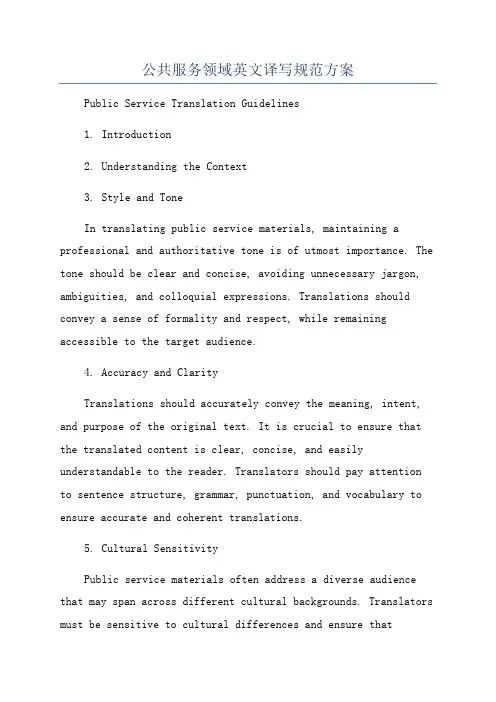
公共服务领域英文译写规范方案Public Service Translation Guidelines1. Introduction2. Understanding the Context3. Style and ToneIn translating public service materials, maintaining a professional and authoritative tone is of utmost importance. The tone should be clear and concise, avoiding unnecessary jargon, ambiguities, and colloquial expressions. Translations should convey a sense of formality and respect, while remaining accessible to the target audience.4. Accuracy and ClarityTranslations should accurately convey the meaning, intent, and purpose of the original text. It is crucial to ensure that the translated content is clear, concise, and easily understandable to the reader. Translators should pay attention to sentence structure, grammar, punctuation, and vocabulary to ensure accurate and coherent translations.5. Cultural SensitivityPublic service materials often address a diverse audience that may span across different cultural backgrounds. Translators must be sensitive to cultural differences and ensure thattranslations respect cultural norms and avoid any offensive or inappropriate content. If there are cultural concepts that do not have an exact equivalence in the target language,translators should provide explanations or find appropriate alternatives to convey the intended meaning.6. Formatting and PresentationTranslations should be presented in a format and layout consistent with the original document. The use of appropriate headings, subheadings, bullet points, and numbering should be maintained. Translators should strive to reproduce any visual elements such as tables, charts, and diagrams in an accurate and visually appealing manner.7. Terminology and Abbreviations8. Review and EditingAll translations should undergo a thorough review andediting process to ensure accuracy, clarity, and adherence to the guidelines. Reviews can be done by a second translator, subject matter expert, or a language editor proficient in both the source and target languages. Feedback and suggestions should be incorporated into the final translation to improve theoverall quality.9. Feedback and Continuous ImprovementTranslators should actively seek feedback from clients, reviewers, and other stakeholders to improve their translation skills and ensure the highest quality of translated materials. Feedback should be taken constructively, and learnings should be incorporated into future translations.10. Confidentiality and Ethical ConsiderationsTranslators are expected to maintain the confidentiality of all information and documents entrusted to them during the translation process. They must adhere to professional ethical standards, treating all sensitive information with utmost care and respect.ConclusionThese guidelines provide a framework for translating public service materials from Chinese to English effectively and accurately. By following these guidelines, translators can ensure that public service translations are clear, concise, culturally sensitive, and aligned with the intended purpose and tone of the original text.。
公共服务领域英文译写规范Public services refer to the services provided by the government or other organizations to meet the needs of thepublic and promote social development. It includes the production, distribution and use of services such as education, health care, social security, public transportation, civil defense, culture, sports, environmental hygiene, emergency rescue and disaster relief, etc.Public services mainly focus on meeting the needs of the public and protecting the public interest. It is an important part of the system of modern market economy. Public service is a major part of the livelihood of the people, so it is the responsibility of the government to provide the public with quality and efficient public services.In our country, in order to better meet the needs of the public and improve the quality of public services, the government has always been actively carrying out reform and upgrading of public services. Firstly, we have introduced and implemented a series of public service systems and policies such as the public service system reform, the improvement of public service capacity, the guarantee of public service rights and interests, and the establishment of a unified public service platform. Secondly, the government has proposed to build a service-oriented government, strengthen the development ofpublic services and promote the modernization of public management. Finally, the government has actively introduced a variety of advanced technologies to improve the level of public services and realize the modernization of government.。
规范公共服务领域英语作文Title: Enhancing Standards in Public Service: A Vital Imperative。
In recent years, the need to enhance standards in public services has emerged as a critical imperative. Public services play a pivotal role in ensuring the well-being and quality of life for citizens. Therefore, it is imperative to uphold high standards to meet the diverse needs of the populace effectively. This essay explores the significance of standardization in public services and proposes strategies to achieve this goal.First and foremost, standardized public services foster trust and confidence among citizens. When individuals interact with public institutions, they expect consistent and reliable services regardless of their location or circumstances. Standardization ensures uniformity in service delivery, which in turn enhances transparency and accountability. Citizens are more likely to engage withpublic services when they trust that their needs will be addressed efficiently and fairly.Moreover, standardized public services contribute to efficiency and effectiveness. By establishing clear guidelines and protocols, institutions can streamline their operations and minimize redundancies. This not only reduces bureaucratic hurdles but also optimizes resource allocation. As a result, public services can operate more cost-effectively while delivering superior outcomes to the community.Furthermore, standardization facilitatesinteroperability and collaboration across different sectors and jurisdictions. In an increasingly interconnected world, public services often intersect with various stakeholders, including government agencies, nonprofit organizations, and private enterprises. By adhering to common standards and protocols, these entities can seamlessly exchangeinformation and coordinate efforts to tackle complex challenges such as healthcare delivery, education, and disaster response.To achieve comprehensive standardization in public services, several strategies can be adopted. Firstly, there is a need for robust regulatory frameworks that establish minimum standards and guidelines for service delivery. These regulations should be periodically reviewed and updated to reflect evolving needs and best practices. Additionally, capacity-building initiatives are essentialto equip public servants with the skills and knowledge necessary to adhere to these standards effectively.Furthermore, leveraging technology can greatly enhance the standardization of public services. Digital platforms and data analytics can streamline processes, improve decision-making, and enhance service delivery. For instance, electronic medical records can ensure continuity of care in healthcare systems, while online portals can facilitate easier access to government services and information.In addition to technological advancements, stakeholder engagement is crucial for fostering a culture of continuous improvement and innovation. By involving citizens, civilsociety organizations, and other stakeholders in the policymaking process, public institutions can gain valuable insights into the diverse needs and preferences of the community. This participatory approach not only enhancesthe legitimacy of decision-making but also fosters a senseof ownership and accountability among all stakeholders.In conclusion, standardization is essential for enhancing the quality, efficiency, and accountability of public services. By establishing clear standards,leveraging technology, and promoting stakeholder engagement, public institutions can ensure that they meet the diverse needs of the populace effectively. Ultimately, standardized public services are essential for promoting inclusive development and improving the overall quality of life for citizens.。
公共服务领域英文译写规范引言在全球化的背景下,英文的使用已经成为各行各业的共同需求,公共服务领域也不例外。
为了保证公共服务信息的准确传达和统一规范,制定一套公共服务领域英文译写规范显得尤为重要。
本文将介绍公共服务领域常用术语的英文表达规范,以期提供统一的翻译准则。
一、字面翻译与准确翻译的选择在翻译公共服务领域的文件时,常会遇到需要选择字面翻译还是准确翻译的情况。
在进行选择时,需要综合考虑以下因素:1.上下文意思:首先要确保翻译后的语句能够准确传达原文的意思,不会因为过于追求字面翻译而造成歧义。
2.行业规范:公共服务领域有一些术语是行业专用或常用的,如果进行准确翻译可能导致术语不统一,因此需要遵循行业规范。
3.可理解性:尽量选择大众可理解的词汇和短语,不过于专业化,以便更好地传达信息。
二、公共服务领域常见术语的英文翻译规范1. 公共服务 (Public Service)公共服务是指政府或公共机构提供给公民的服务,如教育、医疗、交通等。
在翻译时可以直接使用Public Service这个词组进行翻译。
2. 社区服务 (Community Service)社区服务是指提供给社区居民的服务,如社区服务中心、社区义工活动等。
可以将社区服务翻译为Community Service。
3. 公共设施 (Public Facilities)公共设施是指供公众使用的基础设施,如公园、图书馆、博物馆等。
可以将公共设施翻译为Public Facilities。
4. 公益组织 (Nonprofit Organization)公益组织是指为公益事业而设立的组织,如慈善机构、志愿者组织等。
Nonprofit Organization是公益组织的常用翻译。
5. 便民服务 (Convenience Service)便民服务是指为了方便市民生活而提供的服务,如快递、超市等。
可以将便民服务翻译为Convenience Service。
常见公共场所英语标示(国家英文译写规范)第1部分:通则Part 1: General rules场所和机构名称 names of public places and institutions专名 specific terms通名 generic terms公共服务信息 public service information安全线Yellow Line 或Red Line油漆未干Wet Paint老弱病残孕专座Priority Seating 或Courtesy Seat〔其中Seat应视情况选用单数或复数形式〕同仁医院Tongren Hospital希尔顿酒店Hilton Hotel玉佛寺Jade Buddha Temple华联超市Hualian Supermarket豫园Yuyuan Garden梅园村〔饭店名〕Meiyuancun Restaurant北京Beijing华北 North China吉林省Jilin Province吉林市Jilin Municipality北京南站〔火车站〕Beijing South Railway Station西安交通大学Xi’an Jiaotong University中山陵Dr. Sun Yatsen’s Mausoleum残障人士专用Disabled Only残疾人卫生间 Disabled Only残疾人卫生间 Accessible Toilet2号看台Platform 23号登机口 Gate 3一般性警示事项Mind…或Watch…或Beware of…当心碰头Mind Your Head注意脚下、当心踏空、当心台阶Watch Your Step可能导致重大人身伤害、需要突出警示的警告事项CAUTION小心烫伤〔指开水〕CAUTION//Hot Water直接关系生命财产安全、需要引起高度注意的警告事项WARNING或DANGER当心触电 DANGER//High Voltage劝阻性事项Please Do Not …或 Thank You for Noting请勿吸烟Thank You for Not Smoking禁止性译Not…或 Noing 或…Not Allowed禁止吸烟、不准吸烟No Smoking直接关系生命财产安全、需要严令禁止的事项可…Forbidden或Prohibited严禁携带〔燃放〕烟花邊竹Fireworks Prohibited小草有生命,君子足留情Keep off Grass非强制性指示提醒事项,为使语气委婉,使用Please引导请节约用水Please Save Water 或 Please Conserve Water旅客通道,保持畅通Keep Clear直接财产安全、需要强令执行的事项可以使用Must必须戴安全帽Head Protection Must Be Worn 或 All Personnel Must Wear a Hard Hat不准停车,只可上下旅客DROPOFF & PICKUP ONLY 或 DropOff & PickUp Only第2部分:交通Part 2: Transportation道路交通信息 road traffic information公共交通信息 public transportation information高速公路Expressway公路Highway道路Road高架道路Elevated Road环路Ring Road312国道G312前方学校School Ahead禁止长时停车No Parking禁止临时停车、停留No Stopping飞机场Air Port火车站Railway Station大型港口Port客运码头、轮渡站Ferry Terminal 或Pier货运码头Wharf装卸码头Loading/Uploading Dock轨道交通线路Line具体线路Line+阿拉伯数字公共汽车线路Bus Route具体公交线路Route 可省略,直接用阿拉伯数字表示公交63路Bus 63轨道交通站点Station公共汽车始发站和终点站Terminal或Station公共汽车沿途站点Stop飞机或列车上的厕所Lavatory行李Baggage或Luggage民航售票用Airline Tickets1 公路 Highway2 高速公路 Expressway3 干线公路 Trunk Highway4 国道 National Highway5 省道 Provincial Highway6 县道 County Highway7 城市道路 Urban Road8 地面道路 GroundLevel Road9 高架道路 Elevated Road 或Elevated Highway10 支路 Access Road11 辅路 Side Road12 绕城公路; 环路 Beltway 或Ring Road13 主干路 Arterial Road14 次干路 SubArterial Road15 收费公路 Tollway 或Toll Road16 桥梁 Bridge17 高架桥 Overpass [指城市中的高架桥]; Viaduct [指横跨河流或山谷的高架桥]18 立交桥[车行] Highway Interchange 或 Flyover19 安全岛; 交通岛 Refuge Island 或Pedestrian Refuge20 环岛; 环形交叉口 Roundabout21 交通信号灯 Traffic Lights22 标线 Marking23 人行横道线 Pedestrian Crossing24 车辆上下客区 Passenger Pickup and Dropoff Area [Area 可以省略]25 车辆下客区 Passenger Dropoff Area [Area 可省略]26 卡车停靠点 Truck Parking Only 或 Trucks Only27 路侧停车点 Roadside Parking28 公共停车场 Public Parking29 内部停车场 Private Parking [私人用]; Staff Parking [员工用]30 全日停车场[昼夜服务] 24Hour Parking31 免费停车场 Free Parking32 收费停车场 Pay Parking33 残疾人专用停车位 Parking for People With Disabilities34 出租车专用停车位 Taxi Parking Only 或Taxi Only35 非机动车专用停车位 Nonmotor Vehicle Parking Only 或Nonmotor Vehicles Only36 大客车停车位 Bus Parking Only 或Buses Only37 停车港湾 Parking Bay38 专属停车位 Reserved Parking39 临时停车位 Temporary Parking40 计时停车位 Hourly Parking 或Metered Parking第3部分:旅游Part 3: Tourism旅游景区景点 tourist areas and scenic spots 山Mountain或Hill佛教的寺、城隍庙、太庙Temple清真寺 Mosque道教的宫、观Daoist Temple永乐宫Yongle Temple玄妙观 Xuanmiao Temple佛塔Pagoda舍利塔Stupa 或Dagaba其他的塔Tower广播电视塔Radio and TV Tower学生票购票窗口 Student Tickets观光车乘坐点Sightseeing Buses油画柜台Oil Paintings学生票 Student Ticket观光车 Sightseeing Bus油画 Oil Painting缆车Cable Car滑雪场缆车Ski Lift1 景观 Landscape 或 Scenery2 海滩 Beach3 江; 河 River4 溪 Creek 或 Stream5 潭; 池 Pond〔日月潭、天池等已习惯使用Lake的可沿用〕6 湖; 泊 Lake7 瀑布 Falls 或 Waterfall8 冰川 Glacier9 森林、林地 Forest 或 Woods10 湿地 Wetland11 沼泽 Marsh 或 Moor12 峡谷 Gorge 或 Canyon13 山谷 Valley14 山洞 Cave15 溶洞 Karst Cave 或 Limestone Cave16 山 Mountain或Hill〔蛾眉山等习惯使用Mount的可沿用〕17 峰 Peak 或 Mountain Peak18 山脉 Mountains 或 Mountain Range19 雪山 Snow Mountain20 温泉 Hot Spring21 风景名胜; 风景名胜区; 旅游景区 Tourist Attraction〔泛指多处景点时应用复数,Tourist Attractions〕22 景区 Scenic Area23 景点 Scenic Spot24 自然保护区 Natural Reserve 或 Nature Reserve25 水利风景区 Water Conservancy Scenic Area26 国家级景区 National Tourist Attraction27 国家森林公园 National Forest Park28 园; 阙; 苑 Garden29 公园; 综合公园 Park30 城市公园 City Park 或 Urban Park31 民俗园 Folklore Park32 民族风情园 Ethnic Culture Park33 地质公园 Geopark34 湿地公园 Wetland Park35 雕塑公园 Sculpture Park36 主题公园 Theme Park37 森林公园 Forest Park38 生态公园 Ecopark39 植物园 Botanical Garden40 盆景园 Miniature Landscape Garden 或 Potted Landscape Garden41 宫〔皇宫〕; 行宫 Palace42 殿; 堂 Hall43 教堂 Church 或 Cathedral44 廊〔长廊〕 Corridor45 陵; 墓 Tomb 或 Mausoleum46 陵园; 墓园 Cemetery47 庙; 寺〔佛教〕 Temple48 宫; 观〔道教〕 Daoist Temple49 清真寺 Mosque50 庵 Nunnery51 祠〔纪念性〕 Memorial Temple52 宗祠 Ancestral Temple 或 Clan Temple53 牌坊; 牌楼Memorial Gate 或 Memorial Archway54 楼; 塔楼; 阁 Tower55 塔 Pagoda〔佛塔〕; Stupa 或 Dagoba〔舍利塔〕56 世界文化遗产 World Cultural Heritage〔泛指〕或 World Cultural Heritage Site〔特指一处遗产〕57 中国优秀旅游城市 Top Tourist City of China58 爱国主义教育基地 Patriotism Education Base59 名胜古迹 Scenic Spots and Historical Sites〔泛指多处景点〕60 国家级文物保护单位 National Cultural Heritage Site第4部分:文化娱乐Part 4: Culture and entertainment文化场馆 cultural venue娱乐场所 recreational venue博物馆、科技馆、纪念馆Museum文史馆应Research Institute of Culture and History展览馆、陈列馆、展览中心Exhibition Center或Exhibition Hall美术馆、艺术馆Art Gallery或Art Museum画廊Gallery电影院、电影厅、影都、放映公司及以放电影为主的影剧院Cinema 影城Cinema规模特别大、或者有同名的电影院需要区分的Cinema City或Cineplex 剧场、剧院、舞台、戏院、戏苑Theater。
杭州市公共服务领域外文译写导则Introduction:公共服务是指政府为满足公众需求而提供的各种服务。
杭州市作为中国的一座现代化都市,注重公共服务领域的国际交流与合作。
为了加强与国际社会的沟通与合作,杭州市制定了公共服务领域外文译写导则。
I. 目的和适用范围本导则的目的是规范杭州市公共服务领域的外文译写,确保译文准确、通顺、规范。
本导则适用于杭州市公共服务领域的所有文件、公告、宣传材料等。
II. 基本原则1. 准确性: 译文应准确传达原文的意思,避免歧义和错误信息的出现。
2. 通顺性: 译文应符合英文表达习惯,语句通顺自然。
3. 一致性: 在同一文档中,相同术语和概念应保持一致的翻译。
4. 简洁性: 译文应尽量简洁明了,避免冗长和复杂的表达。
III. 翻译原则1. 译名准确性: 译名应准确反映原文中的名称,避免音译和意译的混淆。
2. 术语翻译: 对于特定领域的术语,应根据行业标准或国际通用术语进行翻译。
3. 文化适应性: 在翻译时应考虑目标语言的文化习惯和习语,以确保译文易于理解和接受。
4. 语法规范性: 译文应符合目标语言的语法规范,避免句子结构混乱或语法错误。
IV. 样式指南1. 标点符号: 英文标点符号应符合英语写作规范,例如句号、逗号、破折号等。
2. 大小写: 标题、专有名词等应根据英语写作规范进行大小写处理。
3. 缩写和缩写词: 缩写和缩写词应使用标准的英文缩写形式,并在首次出现时给出完整解释。
4. 数字和日期: 数字和日期应根据目标语言的习惯进行翻译,避免直接使用中文数字和日期格式。
5. 文档格式: 译文应符合常见的文档格式要求,包括页边距、行间距、字体等。
V. 译者责任1. 准备工作: 译者应事先了解公共服务领域的相关知识和术语,以便更好地翻译。
2. 译文审校: 译者应对自己的译文进行审校,确保准确性和通顺性。
3. 反馈和改进: 译者应接受他人的反馈和建议,并根据需要进行译文的改进和修订。
公共服务领域英文译写规范全文一、总则1.1 为了规范公共服务领域的英文译写,提高英文译写的准确性和规范性,满足国际交流的需要,制定本规范。
1.2 本规范适用于我国公共服务领域各类标识、指示牌、宣传材料、电子屏幕等英文译写。
1.3 英文译写应遵循准确性、简洁性、通用性、尊重原文原则,确保译写内容符合国际惯例和英语语法规则。
二、英文译写基本要求2.1 词汇选用2.1.1 应选用国际通用、简明易懂的英语词汇,避免使用生僻、难以理解的词汇。
2.1.2 对于具有中国特色的词汇,若无对应英文,可采用音译、意译或加注中文拼音的方式。
2.1.3 专有名词应遵循国际通用译名,如“北京”译为“Beijing”。
2.2 语法结构2.2.1 英文译写应遵循英语语法规则,句子结构清晰,表达简洁。
2.2.2 英文译写中的时态、语态、主谓一致等语法现象应符合英语表达习惯。
2.3 标点符号2.3.1 英文译写中的标点符号应遵循英语标点符号用法。
2.3.2 中文标点符号在英文译写中应转换为相应英文标点符号。
三、具体译写规范3.1 地名译写3.1.1 地名译写应遵循《世界地名翻译大辞典》等权威工具书的规定。
3.1.2 地名中的行政区划名称、山川湖泊名称等,应采用国际通用译名。
3.2 公共设施译写3.2.1 公共设施名称的译写,应简洁明了,易于识别。
3.2.2 公共设施名称中的功能、用途等词汇,应选用国际通用、简明易懂的英语词汇。
3.3 指示标识译写3.3.1 指示标识的译写,应简洁明了,具有指导性。
3.3.2 指示标识中的动词、名词等,应选用国际通用、简明易懂的英语词汇。
3.4 宣传材料译写3.4.1 宣传材料的译写,应遵循原文意思,确保信息准确传达。
3.4.2 宣传材料中的、口号等,应简洁明了,具有吸引力。
3.5 电子屏幕译写3.5.1 电子屏幕的译写,应简洁明了,便于快速阅读。
3.5.2 电子屏幕中的滚动字幕,应采用简洁、易懂的英语表达。
《公共服务领域英文译写规范》第9部分:餐饮住宿Guidelinesfor the use of English in public service areasPart 9: Accommodation andcatering附录A餐饮业、住宿业场所和机构名称英文译法示例说明1、“〔〕”中的内容是对英文译法的解释说明,“()”及其所包含的内容是译文的组成部分,使用时应完整译写;2、“或”前后所列出的不同译法可任意选择使用,“;”前后所列出的不同译法应根据相关解释说明区分不同情况选择使用。
A.1 餐饮业场所和机构名称英文译法示例1 餐馆;饭店; 食府Restaurant2 餐饮广场; 美食城Food Court 或Food Plaza3 美食街Food Street4 火锅店Hot Pot Restaurant〔Restaurant可以省略〕5 烧烤店Grill House 或Barbecue Restaurant〔Restaurant 可省略〕6 清真餐馆Halal Restaurant 或Halal Food〔Halal 也可Muslim〕7 快餐店Snack Bar 或Fast Food Restaurant〔Restaurant 可以省略〕8 连锁快餐店Fast Food Chain9 饮食店; 餐饮店;小饭馆Eatery10 食品店Food Store11 面馆Noodle Restaurant 或Noodles〔用于Restaurant 省略时〕12 小吃店Snack Bar 或Snacks13 西餐馆Western Food Restaurant〔Restaurant可以省略〕14 酒吧Bar 或Pub15 小酒吧Mini-Bar16 咖啡馆; 咖啡厅Coffee Shop 或Café17 茶馆Teahouse18 茶室Tearoom19 面包房Bakery20 西饼屋Pastry Store〔Store可以省略〕或BakeryA.2 住宿业场所和机构名称英文译法示例 accommodation1 宾馆;酒店; 旅馆Hotel2 连锁酒店Chain Hotel3 招待所Guesthouse4 客栈Inn5 快捷酒店Budget Hotel6 青年旅社Youth Hostel附录B餐饮业服务信息英文译法示例说明1、“〔〕”中的内容是对英文译法的解释说明,“()”及其所包含的内容是译文的组成部分,使用时应完整译写;2、“”表示书写时应当换行的断行处,需要同行书写是“”应改为句点“.”;3、“”表示使用时应根据实际情况填入具体内容;4、“或”前后所列出的不同译法可任意选择使用,“;”前后所列出的不同译法应根据相关解释说明区分不同情况选择使用。
B.1功能设施信息英文译法示例服务设施1 前台;总台; 接待迎宾Front Desk 或Reception2 订餐处Reservation3 开发票处Invoice and Receipt Issuance大厅、包间4 大堂;大厅Lobby5 宴会厅Banquet Hall6 餐厅Dining Room 〔Room 也可Hall〕或Cafeteria7 贵宾餐厅VIP Dining Room8 自助餐厅Buffet 或Cafeteria9 包间;包房Private Room功能区域10 点菜区Food Ordering Area11 候餐区Waiting Area12 禁烟区; 无烟区Non-Smoking Area13 吸烟区Smoking Area餐具14 餐具Tableware15 餐巾;餐巾纸Napkin16 叉Fork17 刀Knife18 碟Plate19 杯碟Saucer20 杯垫Coaster21 筷子Chopsticks22 汤匙Spoon23 碗Bowl24 烟缸Ashtray调味品、辅料25调味品. Condiments 现Spices26 辅料Ingredients27 奶酪Cheese28 花椒Sichuan Pepper29 糖Sugar30 醋Vinegar31 胡椒粉Pepper32 椒盐粉Peppered Salt33 盐Salt34 黄油Butter35 酱油Soy Sauce36 果酱Jam37 色拉酱Salad Dressings38 蜂蜜Honey39 鲜奶Milk菜单40 菜单Menu41 酒水单Wine List〔酒类〕; Beverage Menu〔饮料类〕42 套餐菜单Set MenuB.2警示警告信息英文译法示例1 注意高温〔炉灶〕CAUTION//Hot Surface 或CAUTION//Hot2 注意高温〔热菜〕CAUTION//Very Hot Dishes3 正在加热,当心烫伤CAUTION//Hot Surface4 注意,不可食用Not EdibleB.3限令禁止信息英文译法示例1 本柜恕不接受V1P卡VIP Cards Not Accepted2 谢绝外带食物; 外来食品请勿入内Outside Food Not Allowed 或No Outside Food3 文明用餐,请勿喧哗Please Help Maintain a Quiet Atmosphere4 适量取食,请勿浪费Take Only What You Need //Do Not Waste Food5 切勿暴饮暴食Eat Light, Eat Right6 切勿酒后驾车Do Not Drink and DriveB.4 指示指令信息英文译法示例1 请照看好您的小孩Please Do Not Leave Your Child Unattended2 请依次取餐Please Wait in Line3 请加热后食用Heat Before Eating 或Heat Before You Eat4 请不要遗忘个人物品Please Do Not Leave Your Belongings BehindB.5说明提示信息英文译法示例1 免费泊车Free Parking2 代客泊车Valet Parking3 提供酒后代驾服务Designated Driver Service Available 〔Available 可以省略〕4 订餐;订座Table Reservation5 已预订; 预留Reserved6 招牌菜Specialty Dish 或Signature Dish7 风味食品Special Delicacies8 风味小吃Local Snacks 或Local Delicacies 或Local Food9 餐厅服务员Waiter〔男〕; Waitress〔女〕10 厨师Chef11 厨师长Head Chef12 调酒师BartenderB.6其他餐饮信息英文译法示例餐1 中餐Chinese Food 或Chinese Cuisine2 西餐Western Food 或Western Cuisine3 快餐Fast Food4 中式快餐Chinese Fast Food5 自助餐Buffet菜6 凉菜Cold Dishes7 热菜;热炒Hot Dishes8 荤菜Meat Dishes9 素菜Vegetable Dishes10 汤Soup11 水果Fruits中国菜系12 鲁菜〔山东菜〕Shandong Cuisine13 川菜〔四川菜〕Sichuan Cuisine14 粤菜〔广东菜〕Guangdong Cuisine15 淮扬菜Huaiyang Cuisine16 闽菜〔福建菜〕Fujian Cuisine17 浙菜〔浙江菜〕Zhejiang Cuisine18 湘菜〔湖南菜〕Hunan Cuisine19 徽菜〔安徽菜〕Anhui Cuisine20 清真菜Halal Food 或Muslim Food21 斋菜Buddhist Food原材料22 素食菜Vegetarian Food23 肉类Meat24 猪肉Pork25 牛肉Beef26 牛排Steak27 羊肉Mutton28 羊肉串Mutton Shashlik29 羊排Lamb Chop 或Mutton Chop30 鸡肉Chicken31 鸭肉Duck32 鱼类Fish33 海鲜Seafood34 虾类Prawn 或Shrimp35 蟹类Crab36 豆制品Bean Products37 豆腐Doufu 或Bean Curd38 蔬菜Vegetables烹饪方法39 火锅Hot Pot40 砂锅Casseroles41 麻辣烫Spicy Hot Pot42 药膳Tonic Diet 或Herbal Cuisine43 烧烤Grill〔在平底锅里烤〕; Barbecue〔直接在火上烤〕口味44 酸Sour45 甜Sweet46 辣Hot 或Spicy47 三分熟Rare48 五分熟Medium49 七分熟Medium Well50 十分熟〔全熟〕Well Done主食51 米饭Rice52 面条Noodles53 拉面Lamian Noodles54 刀削面Daoxiao Noodles55 米线Rice Noodles56 馄饨Huntun 或Wonton57 馅饼Pie58 熟食Delicatessen〔也可简作Deli〕或Cooked Food59 糕点Cakes and Pastries60 月饼Moon Cake61 面包Bread西餐菜类62 开胃菜Appetizer63 主菜Main Course 或Entrée64 配菜Side Dish65 色拉Salad66 比萨Pizza67 三明治Sandwich68 热狗Hot Dog69 甜点Dessert酒水70 国酒;国产酒Chinese Liquors and Wines71 白酒Liquor and Spirits72 黄酒Yellow Rice Wine 或Shaoxing Wine73 米酒Rice Wine74 啤酒Beer75 洋酒Imported Wines and Liquors76 红葡萄酒Red Wine77 白葡萄酒White Wine78 果酒Fruit Wine79 开胃酒Aperitifs80 饮料Beverages 或Drinks81 饮用水Drinking Water82 碳酸饮料Carbonate Beverages 或Sodas83 罐装饮料Canned Drinks84 鲜榨果汁Fresh Juice85 不含酒精类饮料Non-Alcoholic Beverages86 茶Tea87 咖啡Coffee附录C住宿业服务信息英文译法示例说明:1、“〔〕”中的内容是对英文译法的解释说明,“()”及其所包含的内容是译文的组成部分,使用时应完整译写;2、“//”表示书写时应当换行的断行处,需要同行书写是“//”应改为句点“.”;3、“”表示使用时应根据实际情况填入具体内容;4、“或”前后所列出的不同译法可任意选择使用,“;”前后所列出的不同译法应根据相关解释说明区分不同情况选择使用。